Chapter 3. Advanced Red Hat Quay deployment
3.1. Using SSL to protect connections to Red Hat Quay
3.1.1. Introduction to using SSL
To configure Red Hat Quay with a self-signed certificate, you need to create a Certificate Authority (CA) and then generate the required key and certificate files.
The following examples assume you have configured the server hostname quay-server.example.com using DNS or another naming mechanism, such as adding an entry in your /etc/hosts file:
$ cat /etc/hosts ... 192.168.1.112 quay-server.example.com
3.1.2. Create a Certificate Authority and sign a certificate
At the end of this procedure, you will have a certificate file and a primary key file named ssl.cert and ssl.key, respectively.
3.1.2.1. Create a Certificate Authority
Generate the root CA key:
$ openssl genrsa -out rootCA.key 2048
Generate the root CA cert:
$ openssl req -x509 -new -nodes -key rootCA.key -sha256 -days 1024 -out rootCA.pem
Enter the information that will be incorporated into your certificate request, including the server hostname, for example:
Country Name (2 letter code) [XX]:IE State or Province Name (full name) []:GALWAY Locality Name (eg, city) [Default City]:GALWAY Organization Name (eg, company) [Default Company Ltd]:QUAY Organizational Unit Name (eg, section) []:DOCS Common Name (eg, your name or your server's hostname) []:quay-server.example.com
3.1.2.2. Sign a certificate
Generate the server key:
$ openssl genrsa -out ssl.key 2048
Generate a signing request:
$ openssl req -new -key ssl.key -out ssl.csr
Enter the information that will be incorporated into your certificate request, including the server hostname, for example:
Country Name (2 letter code) [XX]:IE State or Province Name (full name) []:GALWAY Locality Name (eg, city) [Default City]:GALWAY Organization Name (eg, company) [Default Company Ltd]:QUAY Organizational Unit Name (eg, section) []:DOCS Common Name (eg, your name or your server's hostname) []:quay-server.example.com
Create a configuration file
openssl.cnf, specifying the server hostname, for example:openssl.cnf
[req] req_extensions = v3_req distinguished_name = req_distinguished_name [req_distinguished_name] [ v3_req ] basicConstraints = CA:FALSE keyUsage = nonRepudiation, digitalSignature, keyEncipherment subjectAltName = @alt_names [alt_names] DNS.1 = quay-server.example.com IP.1 = 192.168.1.112
Use the configuration file to generate the certificate
ssl.cert:$ openssl x509 -req -in ssl.csr -CA rootCA.pem -CAkey rootCA.key -CAcreateserial -out ssl.cert -days 356 -extensions v3_req -extfile openssl.cnf
3.1.3. Configuring SSL using the UI
This section configures SSL using the Quay UI. To configure SSL using the command line interface, see the following section.
Start the
Quaycontainer in configuration mode:$ sudo podman run --rm -it --name quay_config -p 80:8080 -p 443:8443 registry.redhat.io/quay/quay-rhel8:v3.6.8 config secret
-
In the Server Configuration section, select
Red Hat Quay handles TLSfor TLS. Upload the certificate file and private key file created earlier, ensuring that the Server Hostname matches the value used when creating the certs. Validate and download the updated configuration. Stop the
Quaycontainer and then restart the registry:$ sudo podman rm -f quay $ sudo podman run -d --rm -p 80:8080 -p 443:8443 \ --name=quay \ -v $QUAY/config:/conf/stack:Z \ -v $QUAY/storage:/datastorage:Z \ registry.redhat.io/quay/quay-rhel8:v3.6.8
3.1.4. Configuring SSL using the command line
Another option when configuring SSL is to use the command line interface.
Copy the certificate file and primary key file to your configuration directory, ensuring they are named
ssl.certandssl.keyrespectively:$ cp ~/ssl.cert $QUAY/config $ cp ~/ssl.key $QUAY/config $ cd $QUAY/config
Edit the
config.yamlfile and specify that you want Quay to handle TLS:config.yaml
... SERVER_HOSTNAME: quay-server.example.com ... PREFERRED_URL_SCHEME: https ...
Stop the
Quaycontainer and restart the registry:$ sudo podman rm -f quay $ sudo podman run -d --rm -p 80:8080 -p 443:8443 \ --name=quay \ -v $QUAY/config:/conf/stack:Z \ -v $QUAY/storage:/datastorage:Z \ registry.redhat.io/quay/quay-rhel8:v3.6.8
3.1.5. Testing SSL configuration using the command line
Use the
podman logincommand to attempt to log in to the Quay registry with SSL enabled:$ sudo podman login quay-server.example.com Username: quayadmin Password: Error: error authenticating creds for "quay-server.example.com": error pinging docker registry quay-server.example.com: Get "https://quay-server.example.com/v2/": x509: certificate signed by unknown authority
Podman does not trust self-signed certificates. As a workaround, use the
--tls-verifyoption:$ sudo podman login --tls-verify=false quay-server.example.com Username: quayadmin Password: Login Succeeded!
Configuring Podman to trust the root Certificate Authority (CA) is covered in a subsequent section.
3.1.6. Testing SSL configuration using the browser
When you attempt to access the Quay registry, in this case, https://quay-server.example.com, the browser warns of the potential risk:

Proceed to the log in screen, and the browser will notify you that the connection is not secure:
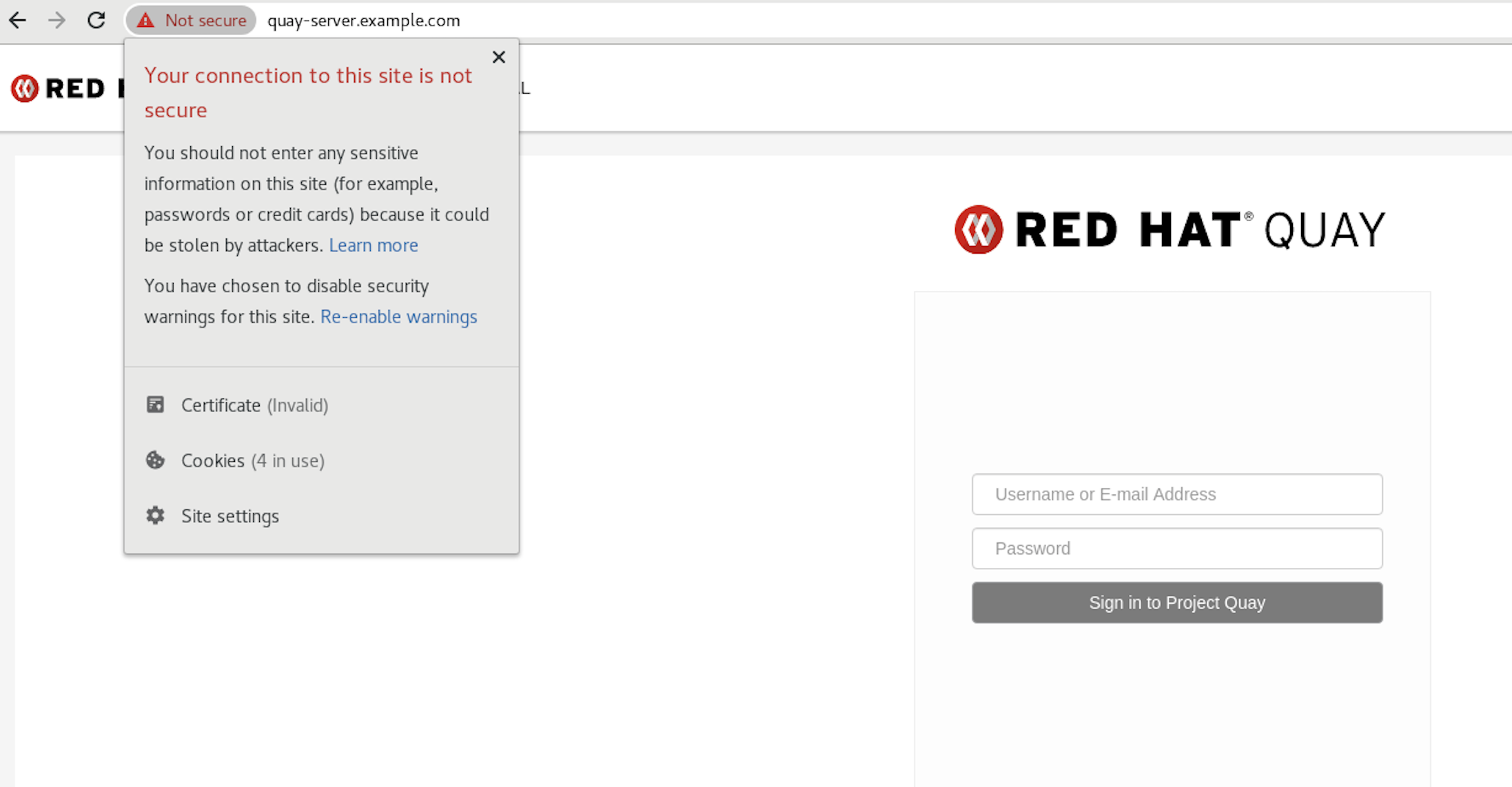
Configuring the system to trust the root Certificate Authority (CA) is covered in the subsequent section.
3.1.7. Configuring podman to trust the Certificate Authority
Podman uses two paths to locate the CA file, namely, /etc/containers/certs.d/ and /etc/docker/certs.d/.
Copy the root CA file to one of these locations, with the exact path determined by the server hostname, and naming the file
ca.crt:$ sudo cp rootCA.pem /etc/containers/certs.d/quay-server.example.com/ca.crt
Alternatively, if you are using Docker, you can copy the root CA file to the equivalent Docker directory:
$ sudo cp rootCA.pem /etc/docker/certs.d/quay-server.example.com/ca.crt
You should no longer need to use the --tls-verify=false option when logging in to the registry:
$ sudo podman login quay-server.example.com Username: quayadmin Password: Login Succeeded!
3.1.8. Configuring the system to trust the certificate authority
Copy the root CA file to the consolidated system-wide trust store:
$ sudo cp rootCA.pem /etc/pki/ca-trust/source/anchors/
Update the system-wide trust store configuration:
$ sudo update-ca-trust extract
You can use the
trust listcommand to ensure that the Quay server has been configured:$ trust list | grep quay label: quay-server.example.comNow, when you browse to the registry at
https://quay-server.example.com, the lock icon shows that the connection is secure:
To remove the root CA from system-wide trust, delete the file and update the configuration:
$ sudo rm /etc/pki/ca-trust/source/anchors/rootCA.pem $ sudo update-ca-trust extract $ trust list | grep quay $
More information can be found in the RHEL 8 documentation in the chapter Using shared system certificates.
3.2. Red Hat Quay superuser
A superuser is a Quay user account that has extended privileges, including the ability to:
- Manage users
- Manage organizations
- Manage service keys
- View the change log
- Query the usage logs
- Create globally visible user messages
3.2.1. Adding a superuser to Quay using the UI
This section covers how to add a superuser using the Quay UI. To add a superuser using the command line interface, see the following section.
Start the
Quaycontainer in configuration mode, loading the existing configuration as a volume:$ sudo podman run --rm -it --name quay_config \ -p 8080:8080 \ -p 443:8443 \ -v $QUAY/config:/conf/stack:Z \ registry.redhat.io/quay/quay-rhel8:v3.6.8 config secret
-
Under the
Access Settingssection of the UI, enter the name of the user (in this instance,quayadmin) in theSuper Usersfield and clickAdd. Validate and download the
configurationfile and then terminate theQuaycontainer that is running in config mode. Extract theconfig.yamlfile to the configuration directory and restart theQuaycontainer in registry mode:$ sudo podman rm -f quay $ sudo podman run -d --rm -p 80:8080 -p 443:8443 \ --name=quay \ -v $QUAY/config:/conf/stack:Z \ -v $QUAY/storage:/datastorage:Z \ registry.redhat.io/quay/quay-rhel8:v3.6.8
3.2.2. Editing the config.yaml file to add a superuser
You can also add a superuser by editing the config.yaml file directly. The list of superuser accounts is stored as an array in the field SUPER_USERS.
Stop the container registry if it is running, and add the
SUPER_USERSarray to theconfig.yamlfile:$QUAY/config/config.yaml
SERVER_HOSTNAME: quay-server.example.com SETUP_COMPLETE: true SUPER_USERS: - quayadmin ...
3.2.3. Accessing the superuser admin panel
Restart the Quay registry:
$ sudo podman rm -f quay $ sudo podman run -d --rm -p 80:8080 -p 443:8443 \ --name=quay \ -v $QUAY/config:/conf/stack:Z \ -v $QUAY/storage:/datastorage:Z \ registry.redhat.io/quay/quay-rhel8:v3.6.8
Access the Super User Admin Panel by clicking on the current user’s name or avatar in the top right-hand corner of the UI. If the user has been added as a superuser, an extra item is presented in the drop-down list called Super User Admin Panel.

3.2.3.1. Creating a globally visible user message
Using the Superuser Admin Panel, you can create Normal, Warning, or Error messages for your organization.
-
Click your user name in the top right-hand corner of the UI. Select
Super User Admin Panel. -
On the Red Hat Quay Management page, click
Globally visible user messageson the left hand pane. Click
Create Messageto show a drop-down menu containingNormal,Warning, andErrormessage types:
-
Enter a message by selecting
Click to set message, then clickCreate Message.
Messages can be deleted by clicking Options and then Delete Message.
3.3. Repository Mirroring
3.3.1. Repository mirroring
Red Hat Quay repository mirroring lets you mirror images from external container registries (or another local registry) into your Red Hat Quay cluster. Using repository mirroring, you can synchronize images to Red Hat Quay based on repository names and tags.
From your Red Hat Quay cluster with repository mirroring enabled, you can:
- Choose a repository from an external registry to mirror
- Add credentials to access the external registry
- Identify specific container image repository names and tags to sync
- Set intervals at which a repository is synced
- Check the current state of synchronization
To use the mirroring functionality, you need to:
- Enable Repository Mirroring in the Red Hat Quay configuration
- Run a repository mirroring worker
- Create mirrored repositories
All repository mirroring configuration can be performed using the configuration tool UI or via the Quay API
3.3.2. Mirroring configuration UI
Start the
Quaycontainer in configuration mode and select the Enable Repository Mirroring check box. If you want to require HTTPS communications and verify certificates during mirroring, select the HTTPS and cert verification check box.
-
Validate and download the
configurationfile, and then restart Quay in registry mode using the updated config file.
3.3.3. Mirroring worker
To run the repository mirroring worker, start by running a
Quaypod with therepomirroroption:$ sudo podman run -d --name mirroring-worker \ -v $QUAY/config:/conf/stack:Z \ registry.redhat.io/quay/quay-rhel8:v3.6.8 repomirror
If you have configured TLS communications using a certificate
/root/ca.crt, then the following example shows how to start the mirroring worker:$ sudo podman run -d --name mirroring-worker \ -v $QUAY/config:/conf/stack:Z \ -v /root/ca.crt:/etc/pki/ca-trust/source/anchors/ca.crt \ registry.redhat.io/quay/quay-rhel8:v3.6.8 repomirror
3.3.4. Creating a mirrored repository
The steps shown in this section assume you already have enabled repository mirroring in the configuration for your Red Hat Quay cluster and that you have a deployed a mirroring worker.
When mirroring a repository from an external container registry, create a new private repository. Typically the same name is used as the target repository, for example, quay-rhel8:

3.3.4.1. Repository mirroring settings
In the Settings tab, set the Repository State to
Mirror: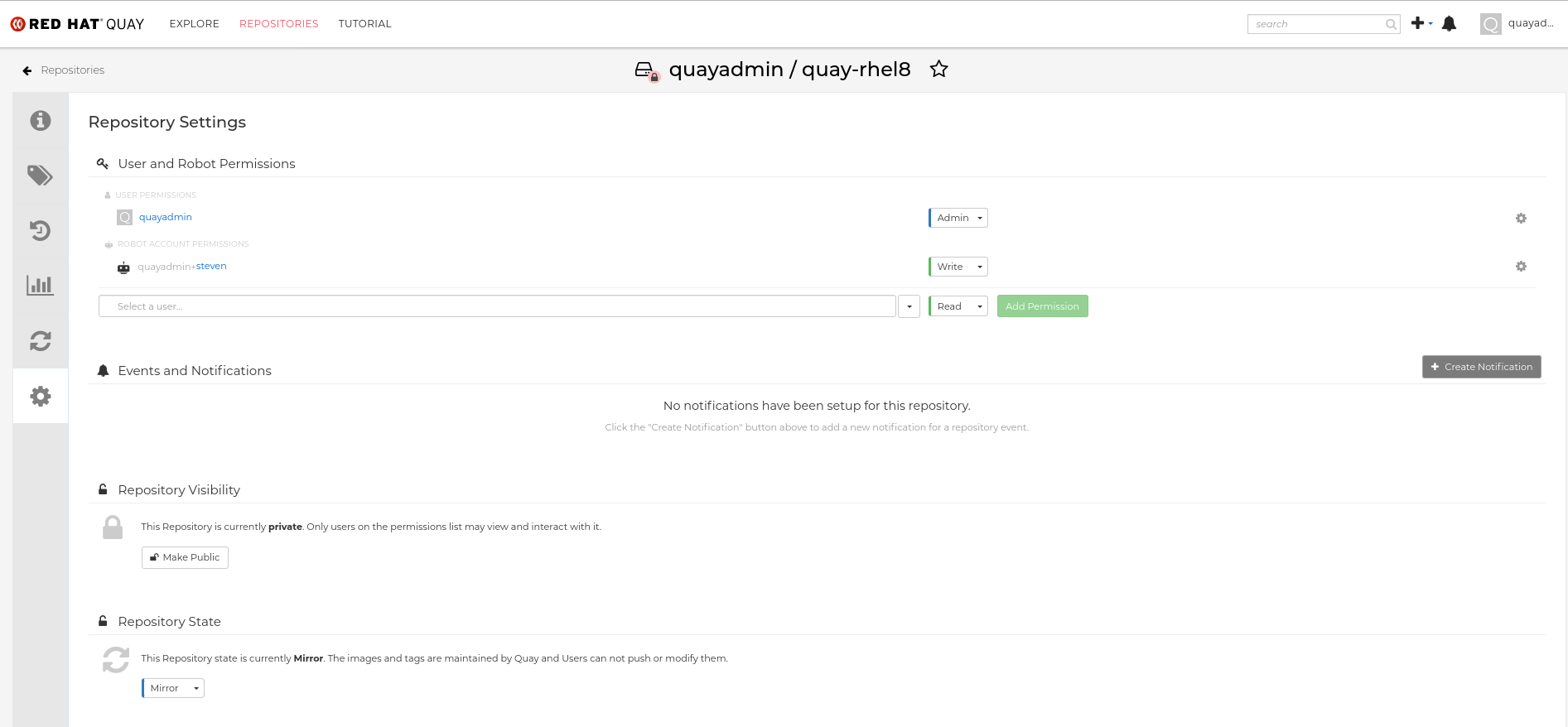
In the Mirror tab, enter the details for connecting to the external registry, along with the tags, scheduling and access information:
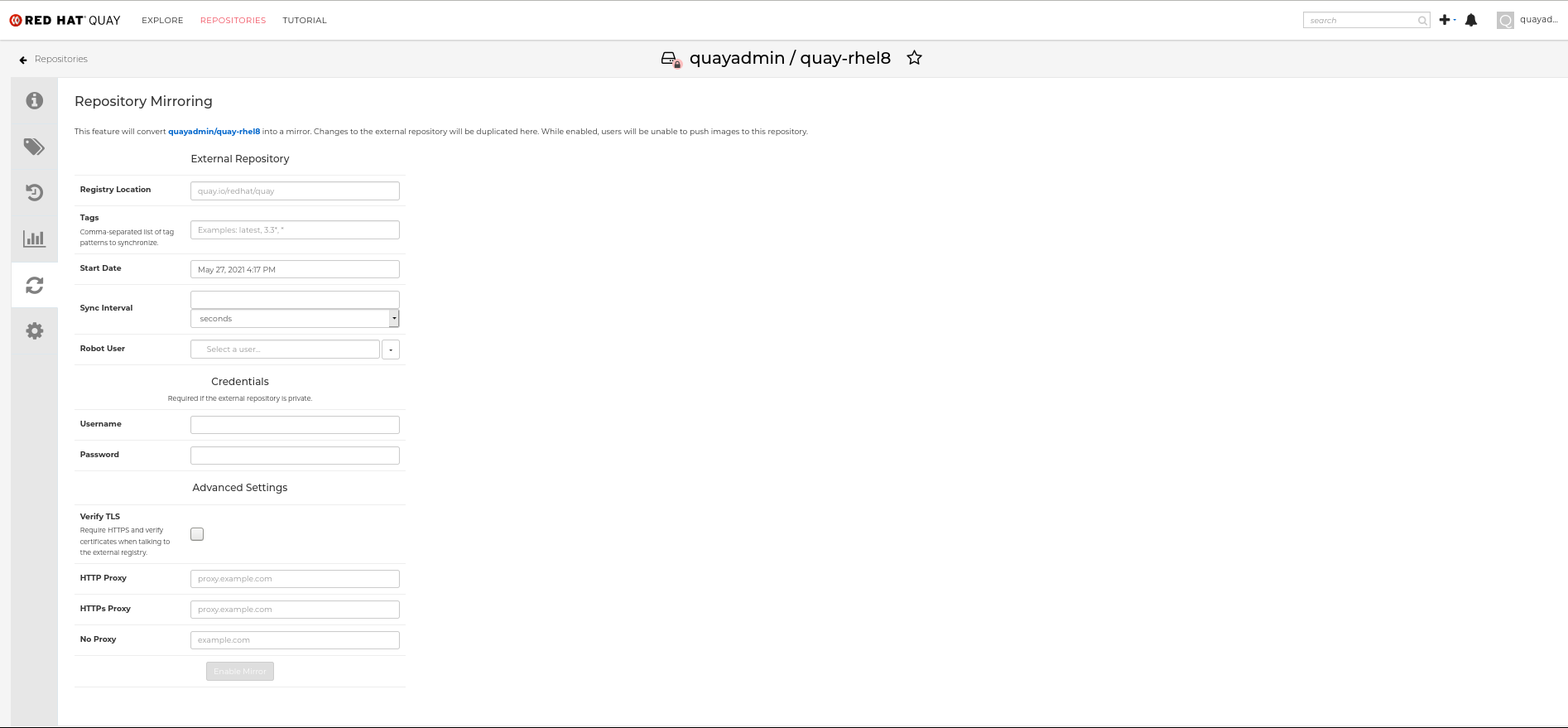
Enter the details as required in the following fields:
-
Registry Location: The external repository you want to mirror, for example,
registry.redhat.io/quay/quay-rhel8 Tags: This field is required. You may enter a comma-separated list of individual tags or tag patterns. (See Tag Patterns section for details.)
NoteIn order for Quay to get the list of tags in the remote repository, one of the following requirements must be met:
- An image with the "latest" tag must exist in the remote repository OR
- At least one explicit tag, without pattern matching, must exist in the list of tags that you specify
- Start Date: The date on which mirroring begins. The current date and time is used by default.
- Sync Interval: Defaults to syncing every 24 hours. You can change that based on hours or days.
- Robot User: Create a new robot account or choose an existing robot account to do the mirroring.
- Username: The username for accessing the external registry holding the repository you are mirroring.
- Password: The password associated with the Username. Note that the password cannot include characters that require an escape character (\).
-
Registry Location: The external repository you want to mirror, for example,
3.3.4.2. Advanced settings
- In the Advanced Settings section, configure TLS and proxy, if required:
- Verify TLS: Check this box if you want to require HTTPS and to verify certificates, when communicating with the target remote registry.
- HTTP Proxy: Identify the HTTP proxy server needed to access the remote site, if one is required.
- HTTPS Proxy: Identify the HTTPS proxy server needed to access the remote site, if one is required.
- No Proxy: List of locations that do not require proxy
3.3.4.3. Synchronize now
To perform an immediate mirroring operation, press the Sync Now button on the repository’s Mirroring tab. The logs are available on the Usage Logs tab:
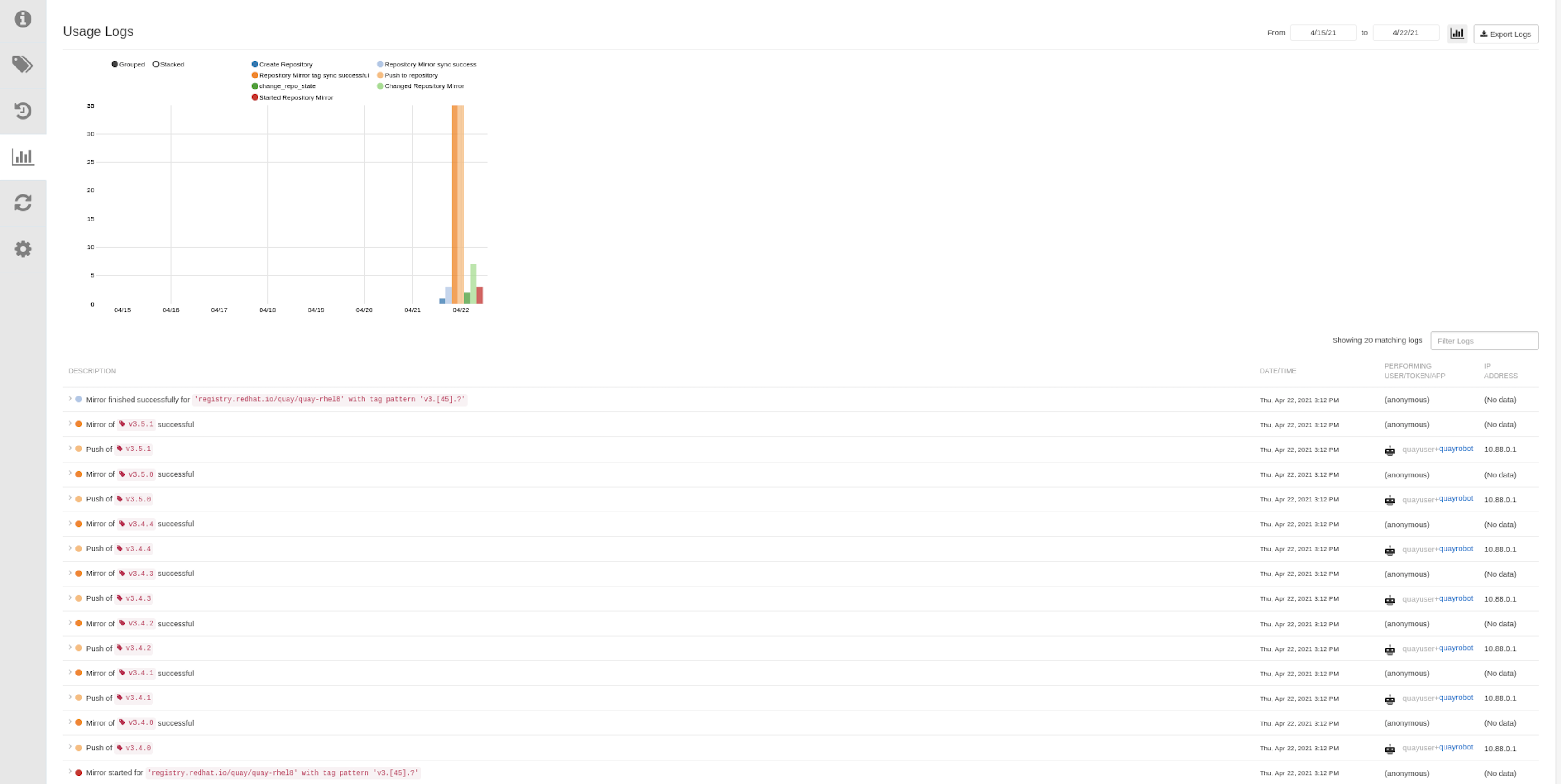
When the mirroring is complete, the images will appear in the Tags tab:

Below is an example of a completed Repository Mirroring screen:

3.3.5. Mirroring tag patterns
As noted above, at least one Tag must be explicitly entered (ie. not a tag pattern) or the tag "latest" must exist in the report repository. (The tag "latest" will not be synced unless specified in the tag list.). This is required for Quay to get the list of tags in the remote repository to compare to the specified list to mirror.
3.3.5.1. Pattern syntax
| Pattern | Description |
| * | Matches all characters |
| ? | Matches any single character |
| [seq] | Matches any character in seq |
| [!seq] | Matches any character not in seq |
3.3.5.2. Example tag patterns
| Example Pattern | Example Matches |
| v3* | v32, v3.1, v3.2, v3.2-4beta, v3.3 |
| v3.* | v3.1, v3.2, v3.2-4beta |
| v3.? | v3.1, v3.2, v3.3 |
| v3.[12] | v3.1, v3.2 |
| v3.[12]* | v3.1, v3.2, v3.2-4beta |
| v3.[!1]* | v3.2, v3.2-4beta, v3.3 |
3.4. Deploying Clair V4
Clair is an application for parsing image contents and reporting vulnerabilities affecting the contents. This is performed via static analysis and not at runtime. Clair’s analysis is broken into three distinct parts:
- Indexing: Indexing starts with submitting a Manifest to Clair. On receipt, Clair will fetch layers, scan their contents, and return an intermediate representation called an IndexReport. Manifests are Clair’s representation of a container image. Clair leverages the fact that OCI Manifests and Layers are content-addressed to reduce duplicated work. Once a Manifest is indexed, the IndexReport is persisted for later retrieval.
- Matching: Matching takes an IndexReport and correlates vulnerabilities affecting the manifest that the report represents. Clair is continually ingesting new security data and a request to the matcher will always provide you with the most up to date vulnerability analysis of an IndexReport.
- Notifications: Clair implements a notification service. When new vulnerabilities are discovered, the notifier service will determine if these vulnerabilities affect any indexed Manifests. The notifier will then take action according to its configuration.
3.4.1. Deploying a separate database for Clair
Clair requires a Postgres database. You can share a common database between Quay and Clair if Quay is also using Postgres, but in this example a separate, Clair-specific database is deployed.
In this proof-of-concept scenario, you will use a directory on the local file system to persist database data.
In the installation folder, denoted here by the variable $QUAY, create a directory for the Clair database data and set the permissions appropriately:
$ mkdir -p $QUAY/postgres-clairv4 $ setfacl -m u:26:-wx $QUAY/postgres-clairv4
Use podman to run the Postgres container, specifying the username, password, database name and port, together with the volume definition for database data. As the standard Postgres port,
5432, is already in use by the Quay deployment, expose a different port, in this instance5433:$ sudo podman run -d --rm --name postgresql-clairv4 \ -e POSTGRESQL_USER=clairuser \ -e POSTGRESQL_PASSWORD=clairpass \ -e POSTGRESQL_DATABASE=clair \ -e POSTGRESQL_ADMIN_PASSWORD=adminpass \ -p 5433:5432 \ -v $QUAY/postgres-clairv4:/var/lib/pgsql/data:Z \ registry.redhat.io/rhel8/postgresql-10:1
Ensure that the Postgres
uuid-osspmodule is installed, as it is required by Clair:$ sudo podman exec -it postgresql-clairv4 /bin/bash -c 'echo "CREATE EXTENSION IF NOT EXISTS \"uuid-ossp\"" | psql -d clair -U postgres'
3.4.2. Quay configuration for Clair
Stop the
Quaycontainer if it is running, and restart it in configuration mode, loading the existing configuration as a volume:$ sudo podman run --rm -it --name quay_config \ -p 80:8080 -p 443:8443 \ -v $QUAY/config:/conf/stack:Z \ registry.redhat.io/quay/quay-rhel8:v3.6.8 config secret
Log in to the configuration tool and enable scanning in the Security Scanner section of the UI. Set the HTTP endpoint for Clair using a port that is not already in use on the
quay-serversystem, for example8081. Create a Clair pre-shared key (PSK) using theGenerate PSKbutton, for example:-
Security Scanner Endpoint:
http://quay-server.example.com:8081 Security Scanner PSK:
MTU5YzA4Y2ZkNzJoMQ==The UI for setting the scanner data is shown in the following image:
Security Scanner UI

-
Security Scanner Endpoint:
Validate and download the
configurationfile and then stop theQuaycontainer that is running the configuration editor. Extract the configuration bundle as before into the$QUAY/configdirectory.$ cp ~/Downloads/quay-config.tar.gz $QUAY/config $ cd $QUAY/config $ tar xvf quay-config.tar.gz
The Quay configuration file is now updated to contain the following fields for the security scanner:
$QUAY/config/config.yaml
... FEATURE_SECURITY_NOTIFICATIONS: false FEATURE_SECURITY_SCANNER: true ... SECURITY_SCANNER_INDEXING_INTERVAL: 30 SECURITY_SCANNER_V4_ENDPOINT: http://quay-server.example.com:8081 SECURITY_SCANNER_V4_PSK: MTU5YzA4Y2ZkNzJoMQ== SERVER_HOSTNAME: quay-server.example.com ...
3.4.3. Clair configuration
Detailed information on Clair configuration is available at https://github.com/quay/clair/blob/main/Documentation/reference/config.md.
Create a config.yaml file in your
/etc/directory, for example,/etc/clairv4/config/config.yaml. Use the following example, which provides a minimal configuration for use in a proof of concept deployment:http_listen_addr: :8081 introspection_addr: :8089 log_level: debug indexer: connstring: host=quay-server.example.com port=5433 dbname=clair user=clairuser password=clairpass sslmode=disable scanlock_retry: 10 layer_scan_concurrency: 5 migrations: true matcher: connstring: host=quay-server.example.com port=5433 dbname=clair user=clairuser password=clairpass sslmode=disable max_conn_pool: 100 run: "" migrations: true indexer_addr: clair-indexer notifier: connstring: host=quay-server.example.com port=5433 dbname=clair user=clairuser password=clairpass sslmode=disable delivery_interval: 1m poll_interval: 5m migrations: true auth: psk: key: "MTU5YzA4Y2ZkNzJoMQ==" iss: ["quay"] # tracing and metrics trace: name: "jaeger" probability: 1 jaeger: agent_endpoint: "localhost:6831" service_name: "clair" metrics: name: "prometheus"-
http_listen_addris set to the port of the Clair HTTP endpoint that you specified in the Quay configuration tool, in this case:8081. -
The Clair pre-shared key (PSK) that you generated in the Quay configuration tool is used for authentication, with the issuer, specified in the
issfield, set toquay.
3.4.4. Running Clair
Use the
podman runcommand to run the Clair container, exposing the HTTP endpoint port that you specified in the configuration tool, in this case8081:$ sudo podman run -d --rm --name clairv4 \ -p 8081:8081 -p 8089:8089 \ -e CLAIR_CONF=/clair/config.yaml -e CLAIR_MODE=combo \ -v /etc/clairv4/config:/clair:Z \ registry.redhat.io/quay/clair-rhel8:v3.6.8
Next, restart the
Quaycontainer using the updated configuration file containing the scanner settings:$ sudo podman run -d --rm -p 80:8080 -p 443:8443 \ --name=quay \ -v $QUAY/config:/conf/stack:Z \ -v $QUAY/storage:/datastorage:Z \ registry.redhat.io/quay/quay-rhel8:v3.6.8
3.4.5. Using Clair security scanning
From the command line, log in to the registry:
$ sudo podman login --tls-verify=false quay-server.example.com Username: quayadmin Password: Login Succeeded!
Pull, tag and push a sample image to the registry:
$ sudo podman pull ubuntu:20.04 $ sudo podman tag docker.io/library/ubuntu:20.04 quay-server.example.com/quayadmin/ubuntu:20.04 $ sudo podman push --tls-verify=false quay-server.example.com/quayadmin/ubuntu:20.04
The results from the security scanning can be seen in the Quay UI, as shown in the following images:
Scanning summary

Scanning details
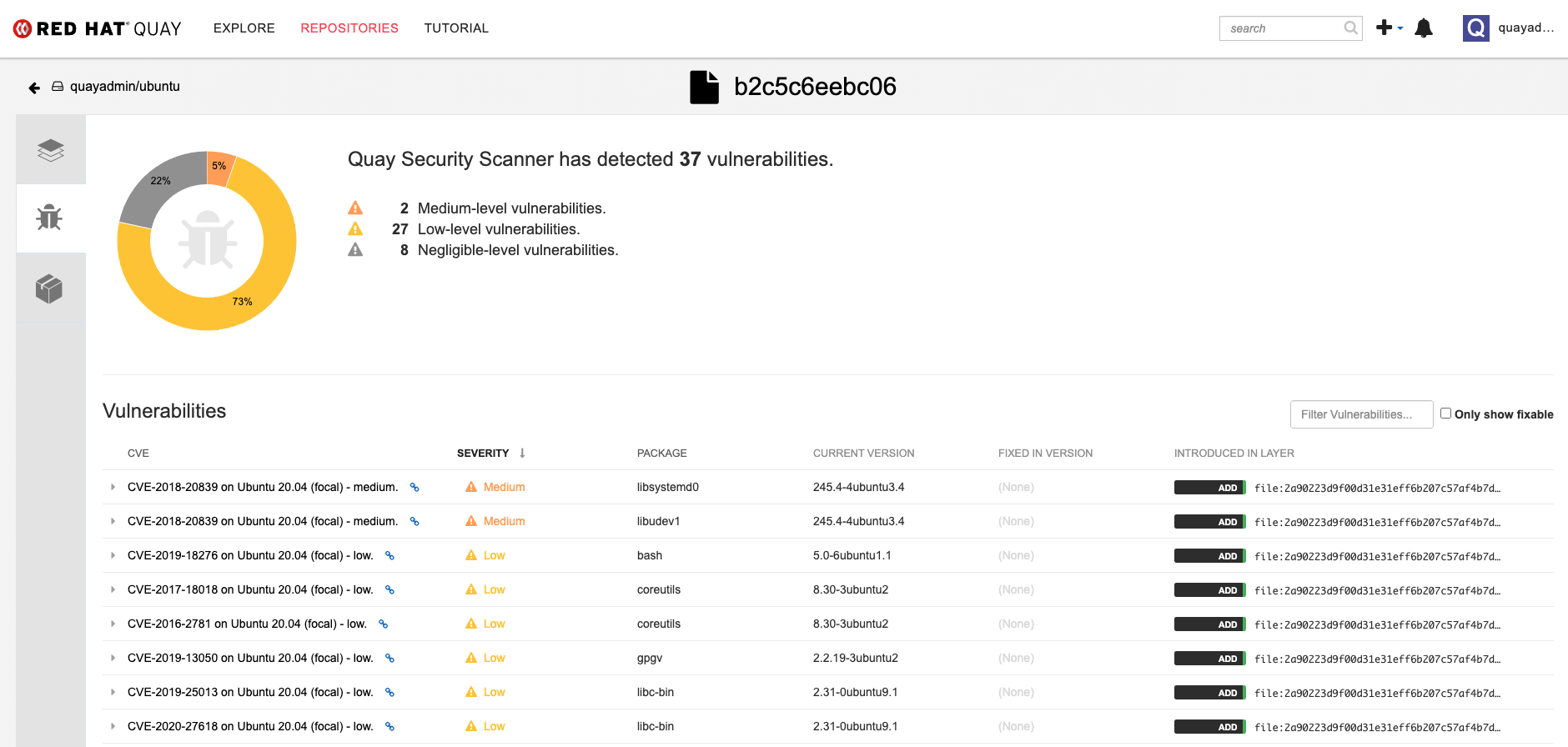
3.4.6. CVE ratings from the National Vulnerability Database
With Clair v4.2, enrichment data is now viewable in the Quay UI. Additionally, Clair v4.2 adds CVSS scores from the National Vulnerability Database for detected vulnerabilities.
With this change, if the vulnerability has a CVSS score that is within 2 levels of the distro’s score, the Quay UI present’s the distro’s score by default. For example:

This differs from the previous interface, which would only display the following information:

3.5. Restarting containers
Because the --restart option is not fully supported by podman, you can configure podman as a systemd service, as described in Porting containers to systemd using Podman
3.5.1. Using systemd unit files with Podman
By default, Podman generates a unit file for existing containers or pods. You can generate more portable systemd unit files using the podman generate systemd --new command. The --new flag instructs Podman to generate unit files that create, start and remove containers.
Create the systemd unit files from a running Red Hat Quay registry as follows:
$ sudo podman generate systemd --new --files --name redis $ sudo podman generate systemd --new --files --name postgresql-quay $ sudo podman generate systemd --new --files --name quay $ sudo podman generate systemd --new --files --name postgresql-clairv4 $ sudo podman generate systemd --new --files --name clairv4
Copy the unit files to
/usr/lib/systemd/systemfor installing them as a root user:$ sudo cp -Z container-redis.service /usr/lib/systemd/system $ sudo cp -Z container-postgresql-quay.service /usr/lib/systemd/system $ sudo cp -Z container-quay.service /usr/lib/systemd/system $ sudo cp -Z container-postgresql-clairv4.service /usr/lib/systemd/system $ sudo cp -Z container-clairv4.service /usr/lib/systemd/system
Reload systemd manager configuration:
$ sudo systemctl daemon-reload
Enable the services and start them at boot time:
$ sudo systemctl enable --now container-redis.service $ sudo systemctl enable --now container-postgresql-quay.service $ sudo systemctl enable --now container-quay.service $ sudo systemctl enable --now container-postgresql-clairv4.service $ sudo systemctl enable --now container-clairv4.service
3.5.2. Starting, stopping and checking the status of services
Check the status of the Quay components:
$ sudo systemctl status container-redis.service $ sudo systemctl status container-postgresql-quay.service $ sudo systemctl status container-quay.service $ sudo systemctl status container-postgresql-clairv4.service $ sudo systemctl status container-clairv4.service
To stop the Quay component services:
$ sudo systemctl stop container-redis.service $ sudo systemctl stop container-postgresql-quay.service $ sudo systemctl stop container-quay.service $ sudo systemctl stop container-postgresql-clairv4.service $ sudo systemctl stop container-clairv4.service
To start the Quay component services:
$ sudo systemctl start container-redis.service $ sudo systemctl start container-postgresql-quay.service $ sudo systemctl start container-quay.service $ sudo systemctl start container-postgresql-clairv4.service $ sudo systemctl start container-clairv4.service
3.5.3. Testing restart after reboot
Once you have the services configured and enabled, reboot the system. When the system has re-started, use podman ps to check that all the containers for the Quay components have been restarted:
$ sudo podman ps -a CONTAINER ID IMAGE COMMAND CREATED STATUS PORTS NAMES 4e87c7889246 registry.redhat.io/rhel8/postgresql-10:1 run-postgresql 19 seconds ago Up 18 seconds ago 0.0.0.0:5432->5432/tcp postgresql-quay b8fbac1920d4 registry.redhat.io/rhel8/redis-5:1 run-redis 19 seconds ago Up 18 seconds ago 0.0.0.0:6379->6379/tcp redis d959d5bf7a24 registry.redhat.io/rhel8/postgresql-10:1 run-postgresql 18 seconds ago Up 18 seconds ago 0.0.0.0:5433->5432/tcp postgresql-clairv4 e75ff8651dbd registry.redhat.io/quay/clair-rhel8:v3.4.0 18 seconds ago Up 17 seconds ago 0.0.0.0:8081->8080/tcp clairv4
In this instance, the Quay container itself has failed to start up. This is due to the fact that, when security scanning is enabled in Quay, it tries to connect to Clair on startup. However, Clair has not finished initializing and cannot accept connections and, as a result, Quay terminates immediately. To overcome this issue, you need to configure the Quay service to have a dependency on the Clair service, as shown in the following section.
3.5.4. Configuring Quay’s dependency on Clair
In the systemd service file for Quay, set up a dependency on the Clair service in the [Unit] section by setting After=container-clairv4.service. To give the Clair container time to initialize, add a delay in the [Service] section, for example RestartSec=30. Here is an example of the modified Quay file, after configuring the dependency on Clair:
/usr/lib/systemd/system/container-quay.service
# container-quay.service # autogenerated by Podman 2.0.5 # Tue Feb 16 17:02:26 GMT 2021 [Unit] Description=Podman container-quay.service Documentation=man:podman-generate-systemd(1) Wants=network.target After=container-clairv4.service [Service] Environment=PODMAN_SYSTEMD_UNIT=%n Restart=on-failure RestartSec=30 ExecStartPre=/bin/rm -f %t/container-quay.pid %t/container-quay.ctr-id ExecStart=/usr/bin/podman run --conmon-pidfile %t/container-quay.pid --cidfile %t/container-quay.ctr-id --cgroups=no-conmon -d --rm -p 8080:8080 --name=quay -v /home/user1/quay/config:/conf/stack:Z -v /home/user1/quay/storage:/datastorage:Z registry.redhat.io/quay/quay-rhel8:v3.4.0 ExecStop=/usr/bin/podman stop --ignore --cidfile %t/container-quay.ctr-id -t 10 ExecStopPost=/usr/bin/podman rm --ignore -f --cidfile %t/container-quay.ctr-id PIDFile=%t/container-quay.pid KillMode=none Type=forking [Install] WantedBy=multi-user.target default.target
Once you have updated the Quay service configuration, reboot the server and immediately run podman ps:
$ sudo podman ps -a CONTAINER ID IMAGE COMMAND CREATED STATUS PORTS NAMES 4e87c7889246 registry.redhat.io/rhel8/postgresql-10:1 run-postgresql 29 seconds ago Up 28 seconds ago 0.0.0.0:5432->5432/tcp postgresql-quay b8fbac1920d4 registry.redhat.io/rhel8/redis-5:1 run-redis 29 seconds ago Up 28 seconds ago 0.0.0.0:6379->6379/tcp redis d959d5bf7a24 registry.redhat.io/rhel8/postgresql-10:1 run-postgresql 28 seconds ago Up 28 seconds ago 0.0.0.0:5433->5432/tcp postgresql-clairv4 e75ff8651dbd registry.redhat.io/quay/clair-rhel8:v3.4.0 28 seconds ago Up 27 seconds ago 0.0.0.0:8081->8080/tcp clairv4
Initially, the Quay container will not be available, but once the RestartSec delay has expired, it should start up:
$ sudo podman ps -a CONTAINER ID IMAGE COMMAND CREATED STATUS PORTS NAMES 4e87c7889246 registry.redhat.io/rhel8/postgresql-10:1 run-postgresql 35 seconds ago Up 34 seconds ago 0.0.0.0:5432->5432/tcp postgresql-quay ab9f0e6ad7c3 registry.redhat.io/quay/quay-rhel8:v3.4.0 registry 3 seconds ago Up 2 seconds ago 0.0.0.0:8080->8080/tcp quay b8fbac1920d4 registry.redhat.io/rhel8/redis-5:1 run-redis 35 seconds ago Up 34 seconds ago 0.0.0.0:6379->6379/tcp redis d959d5bf7a24 registry.redhat.io/rhel8/postgresql-10:1 run-postgresql 34 seconds ago Up 34 seconds ago 0.0.0.0:5433->5432/tcp postgresql-clairv4 e75ff8651dbd registry.redhat.io/quay/clair-rhel8:v3.4.0 34 seconds ago Up 33 seconds ago 0.0.0.0:8081->8080/tcp clairv4
The CREATED field for the Quay container shows the 30 second difference in creation time, as configured in the service definition.
Log in to the Red Hat Quay registry at quay-server.example.com and ensure that everything has restarted correctly.
3.6. FIPS readiness and compliance
FIPS (the Federal Information Processing Standard developed by the National Institute of Standards and Technology, NIST) is regarded as the gold standard for securing and encrypting sensitive data, particularly in heavily regulated areas such as banking, healthcare and the public sector. Red Hat Enterprise Linux and Red Hat OpenShift Container Platform support this standard by providing a FIPS mode in which the system would only allow usage of certain, FIPS-validated cryptographic modules, like openssl. This ensures FIPS compliance.
Red Hat Quay supports running on RHEL and OCP in FIPS mode in production since version 3.5. Furthermore, Red Hat Quay itself also commits to exclusively using cryptography libraries that are validated or are in the process of being validated by NIST. Red Hat Quay 3.5 has pending FIPS 140-2 validation based on the RHEL 8.3 cryptography libraries. As soon as that validation is finalized, Red Hat Quay will be officially FIPS compliant.

